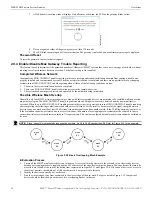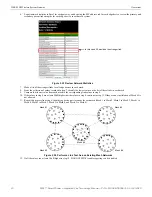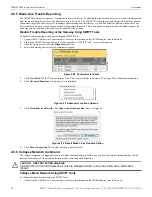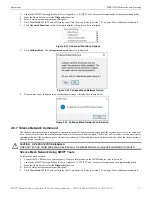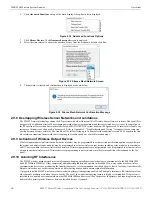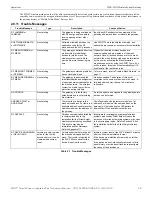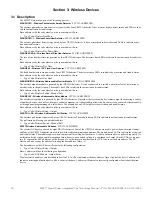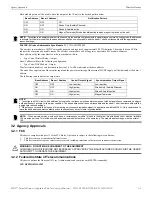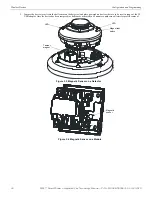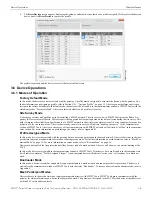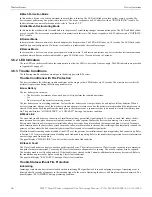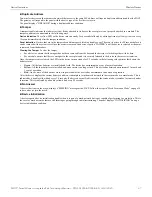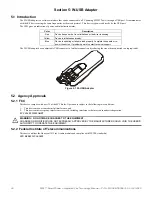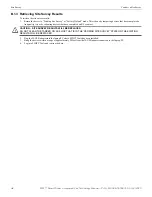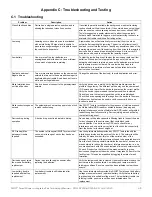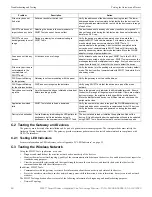
36
SWIFT® Smart Wireless Integrated Fire Technology Manual —
P/N LS10036-000SK-E:G 4/13/2020
Wireless Devices
Device Operations
Mesh Formation Mode
In this mode, a device is an active participant in a mesh that is forming. The LED will blink green then yellow every 6 seconds. The
device cannot perform any fire protection in this state. The device responds to its SLC address with an “INITIALIZING” trouble. For
further information on mesh formation mode, refer to “Section 3.5.2”.
Initial Mesh Restructuring Mode
In this mode, the mesh network is formed and is in the process of establishing stronger communication paths. The LED will blink yellow
every 6 seconds. The device cannot perform any fire protection in this state. The device responds to its SLC address with a “INITIALIZ-
ING” trouble.
Normal Mode
In normal mode, the mesh network is formed and provides fire protection. The LED will blink every 18 seconds. The LED flash can be
disabled by panel configuration. If a device is in trouble, it is indicated by the trouble messages.
Rescue Mode
In rescue mode, a devices is an active participant of a mesh network. It will search and retrieve any device that has lost communication
with the network. Rescue mode is indicated by a green LED blink every 12 seconds for up to 3 minutes.
3.6.2 LED Indicators
The two LEDs on the devices blink in the same pattern to allow the LEDs to be viewed from any angle. The LED indicators are provided
in Appendix D on page 53.
3.6.3 Trouble Conditions
The following trouble conditions are unique to the battery powered RF devices.
Trouble Conditions with Fire Protection
The devices indicate the following trouble conditions with a single yellow LED blink every 14 seconds. The wireless device will still
perform fire protection during the following trouble states.
Low Battery
The low battery event denotes:
• The device has a minimum of one week power left to perform the required operations.
Or
• One (or more) of the batteries is missing or dead.
The low battery event is a latching condition. To clear the low battery event, tamper the device and replace all four batteries. When a
device is tampered, it drops out of the mesh network and attempts to rejoin as soon as the batteries are replaced and the tamper event is
cleared. If the device has dropped from the mesh prior to the tamper event, a system reset has to be issued to clear the low battery trou-
ble. The panel displays “LOW BATTERY” or “LOW BATT” during a low battery condition.
Weak Link
The weak link trouble denotes a connection of insufficient primary parent link signal strength. To resolve a weak link, reduce the dis-
tance between devices, place them away from obstructions, or add a repeater. Tamper the device when moving it to a new location.
Restart mesh formation after a repeater is installed or after a device has been relocated and the tamper condition is cleared. Terminate
mesh formation once the devices have joined the mesh or allow mesh formation to timeout. Restructuring will automatically start and the
gateway will reevaluate the link connectivity between all devices and select suitable signal paths.
Weak link trouble reporting can be disabled at the FACP or at the gateway for installations not requiring primary link connectivity. Refer
to Section 2.9.5 for more information on disabling weak link trouble reporting. Refer to the troubleshooting section for more information
on resolving a weak link condition.
The panel displays “WEAK LINK” for a device that is in the weak link condition.
Class A Fault
The Class A fault denotes a single connection path from the device. The wireless system is a Class A system requiring two communica-
tion paths for normal operations. To remedy the Class A fault, ensure adequate device spacing. The use of a repeater may be required.
The wireless mesh is a self-healing network. If the trouble is not cleared within 5 minutes, additional actions may be required. Refer to
the troubleshooting section for tips on resolving Class A fault conditions.
The panel will display “RF CLASS A” during a Class A fault condition.
Trouble States without Fire Protection
Jamming
Jamming occurs when a device is overloaded with an interfering RF signal but is able to send outgoing messages. A jamming event is
detected after 20 seconds of exposure to the jamming signal. In the event of jamming, the device will drop from the mesh network. The
panel displays “RF JAMMING” during a jamming condition.

